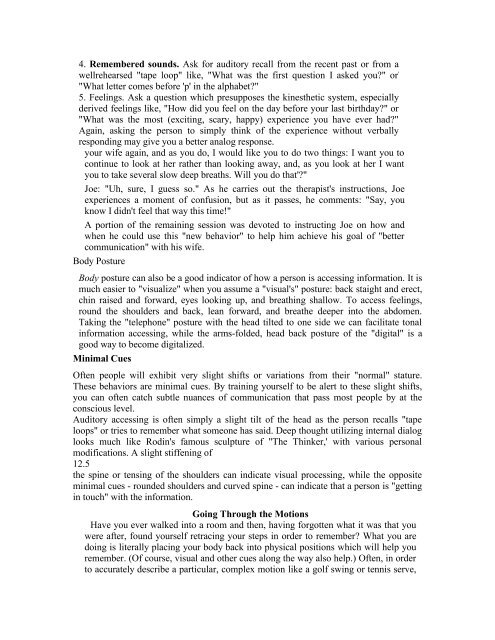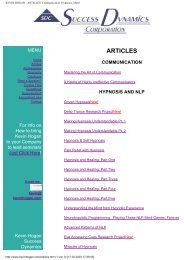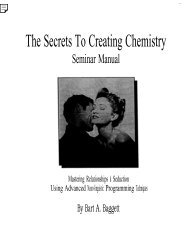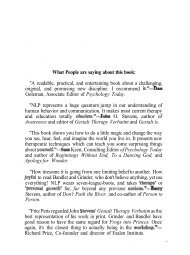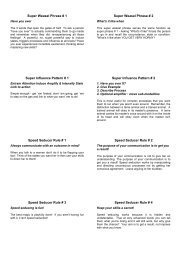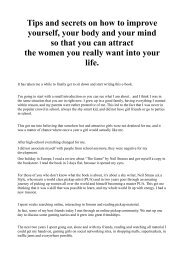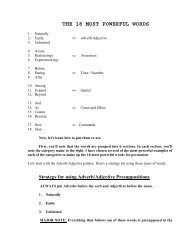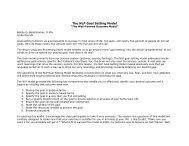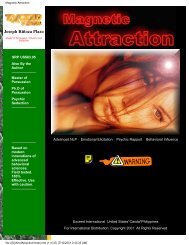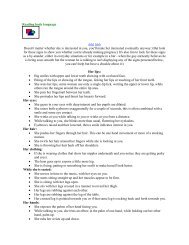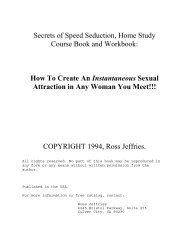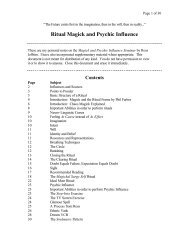A Pragmatic Guide To Communication & Change.pdf - NLP Info Centre
A Pragmatic Guide To Communication & Change.pdf - NLP Info Centre
A Pragmatic Guide To Communication & Change.pdf - NLP Info Centre
- No tags were found...
Create successful ePaper yourself
Turn your PDF publications into a flip-book with our unique Google optimized e-Paper software.
4. Remembered sounds. Ask for auditory recall from the recent past or from a<br />
wellrehearsed "tape loop" like, "What was the first question I asked you?" or '<br />
"What letter comes before 'p' in the alphabet?"<br />
5. Feelings. Ask a question which presupposes the kinesthetic system, especially<br />
derived feelings like, "How did you feel on the day before your last birthday?" or<br />
"What was the most (exciting, scary, happy) experience you have ever had?"<br />
Again, asking the person to simply think of the experience without verbally<br />
responding may give you a better analog response.<br />
your wife again, and as you do, I would like you to do two things: I want you to<br />
continue to look at her rather than looking away, and, as you look at her I want<br />
you to take several slow deep breaths. Will you do that'?"<br />
Joe: "Uh, sure, I guess so." As he carries out the therapist's instructions, Joe<br />
experiences a moment of confusion, but as it passes, he comments: "Say, you<br />
know I didn't feel that way this time!"<br />
A portion of the remaining session was devoted to instructing Joe on how and<br />
when he could use this "new behavior" to help him achieve his goal of "better<br />
communication" with his wife.<br />
Body Posture<br />
Body posture can also be a good indicator of how a person is accessing information. It is<br />
much easier to "visualize" when you assume a "visual's" posture: back staight and erect,<br />
chin raised and forward, eyes looking up, and breathing shallow. <strong>To</strong> access feelings,<br />
round the shoulders and back, lean forward, and breathe deeper into the abdomen.<br />
Taking the "telephone" posture with the head tilted to one side we can facilitate tonal<br />
information accessing, while the arms-folded, head back posture of the "digital" is a<br />
good way to become digitalized.<br />
Minimal Cues<br />
Often people will exhibit very slight shifts or variations from their "normal" stature.<br />
These behaviors are minimal cues. By training yourself to be alert to these slight shifts,<br />
you can often catch subtle nuances of communication that pass most people by at the<br />
conscious level.<br />
Auditory accessing is often simply a slight tilt of the head as the person recalls "tape<br />
loops" or tries to remember what someone has said. Deep thought utilizing internal dialog<br />
looks much like Rodin's famous sculpture of "The Thinker,' with various personal<br />
modifications. A slight stiffening of<br />
12.5<br />
the spine or tensing of the shoulders can indicate visual processing, while the opposite<br />
minimal cues - rounded shoulders and curved spine - can indicate that a person is "getting<br />
in touch" with the information.<br />
Going Through the Motions<br />
Have you ever walked into a room and then, having forgotten what it was that you<br />
were after, found yourself retracing your steps in order to remember? What you are<br />
doing is literally placing your body back into physical positions which will help you<br />
remember. (Of course, visual and other cues along the way also help.) Often, in order<br />
to accurately describe a particular, complex motion like a golf swing or tennis serve,


